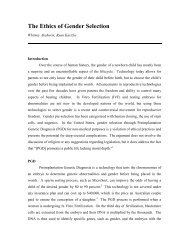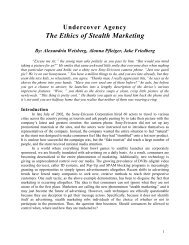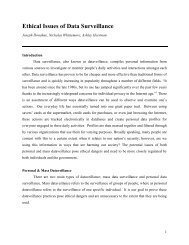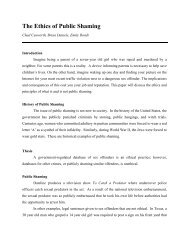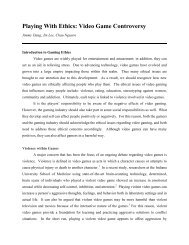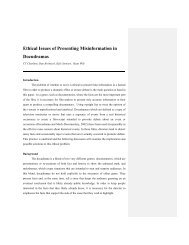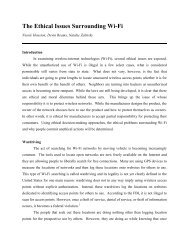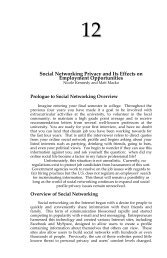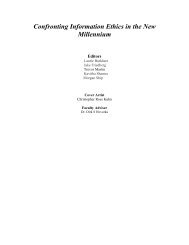Ethics of Facial Recognition Technology - Ethicapublishing.com
Ethics of Facial Recognition Technology - Ethicapublishing.com
Ethics of Facial Recognition Technology - Ethicapublishing.com
Create successful ePaper yourself
Turn your PDF publications into a flip-book with our unique Google optimized e-Paper software.
<strong>Ethics</strong> <strong>of</strong> <strong>Facial</strong> <strong>Recognition</strong> <strong>Technology</strong><br />
David Avexander, Jacob Richert-Boe<br />
_____________________________________________________________<br />
Introduction<br />
In July <strong>of</strong> 2001, construction worker Rob Milliron was eating lunch in Tampa,<br />
Florida‟s Ybor City entertainment district. Unbeknownst to Mr. Milliron, a hidden<br />
government surveillance camera was using facial recognition technology in an attempt to<br />
identify criminals. As Mr. Milliron ate his lunch, these facial recognition systems<br />
captured and stored his image. Without Mr. Milliron‟s consent, his photograph was taken<br />
and used in a U.S. News & World Report article regarding facial recognition technology.<br />
The ac<strong>com</strong>panying headline read: "You can‟t hide those lying eyes in Tampa."<br />
A woman in Oklahoma saw the picture, misidentified Milliron as her ex-husband<br />
wanted on child neglect charges, and called the police. After convincing police he had<br />
never been married, had kids, or even been to Oklahoma, he told the St. Petersburg<br />
Times, "They made me feel like a criminal."(Kopel & Krause, 2002). Cases like Mr.<br />
Milliron‟s showcase the issues surrounding the use <strong>of</strong> facial recognition technology in<br />
public places and the need to address them.<br />
<strong>Facial</strong> <strong>Recognition</strong> <strong>Technology</strong>’s Recent History<br />
Since its introduction to the American public in 2001, facial recognition<br />
technology has grown rapidly and interest in these systems is increasing. <strong>Facial</strong><br />
recognition systems are <strong>com</strong>puter-based security systems that are capable <strong>of</strong> identifying<br />
specified individuals with the use <strong>of</strong> surveillance cameras. Complex algorithms are used<br />
by these systems to <strong>com</strong>pare the faces observed by these camera systems with a database<br />
<strong>of</strong> individual photographs. This allows individuals to monitor other individuals who<br />
<strong>com</strong>e into the camera‟s recording range.<br />
The facial recognition process starts by collecting an image from specified<br />
security cameras. The system then measures the nodal points on the face such as the<br />
distance between the eyes, the shape <strong>of</strong> the cheekbones, and other distinguishable
features. These nodal points are then <strong>com</strong>pared to the nodal points <strong>com</strong>puted from a<br />
database <strong>of</strong> pictures in order to find a match (EPIC, 2006). This technology is currently<br />
being employed by many different businesses and branches <strong>of</strong> the government in an<br />
attempt to improve security. The Department <strong>of</strong> Homeland Security has spent millions <strong>of</strong><br />
dollars on cameras with facial recognition capabilities in an attempt to identify potential<br />
threats to the American people.<br />
Limitations<br />
Although this technology is being used by many different organizations, a number<br />
<strong>of</strong> issues surround its installation and use. Current facial recognition technology is very<br />
inaccurate and has shown to have little or no effect in areas where it was implemented.<br />
Inaccuracies have led to a number <strong>of</strong> false identifications that have been found to harm<br />
individuals. These inaccuracies can be attributed to many factors including image<br />
quality, variations in light and appearance <strong>of</strong> individuals, and the size <strong>of</strong> the photograph<br />
database.<br />
Quality <strong>of</strong> Database Images<br />
One <strong>of</strong> the main factors limiting the success <strong>of</strong> these systems is the quality <strong>of</strong> the<br />
images used in the <strong>com</strong>parisons. In some cases, the images are dated or <strong>of</strong> low quality.<br />
This makes the process <strong>of</strong> matching photographs difficult for the system. Clear images<br />
on both sides <strong>of</strong> the equation are needed to generate an accurate match. In most cases,<br />
however, this is very hard to ac<strong>com</strong>plish and does not occur. Some photographs can be<br />
up to five to ten years old; this is concerning because an individual‟s facial features are<br />
not constant and can change significantly in a short period <strong>of</strong> time: people age, may grow<br />
facial hair, fluctuate in weight, and obtain facial injuries that can all play a part in the<br />
success rate <strong>of</strong> these systems.<br />
The limitations <strong>of</strong> dated photographs are even more evident when the study<br />
conducted by the National Institute <strong>of</strong> Standards and <strong>Technology</strong> (NIST) is considered.<br />
NIST found a 43% false rejection rate for pictures <strong>of</strong> the same person taken one and a<br />
half years apart (Phillips, Martin, Wilson, & Pryzbocki, 2000). It is unfeasible to<br />
continuously collect high resolution up to date photos <strong>of</strong> the individuals the system is
attempting to monitor. Obtaining photographs <strong>of</strong> the desired individuals that the system<br />
can use for accurate <strong>com</strong>parisons can be impossible. This also assumes that the systems<br />
have photographs <strong>of</strong> all the people they are trying to monitor and that they know who<br />
they are monitoring. These systems are unable to identify everyone who is a potential<br />
threat. This technology is useless when it does not have all the photographs required. If<br />
these systems don‟t have a photograph <strong>of</strong> certain individuals then their use is <strong>of</strong> no<br />
concern to those individuals.<br />
Quality <strong>of</strong> Captured Images<br />
Image quality is also affected by variations within the photographs captured by<br />
the system. Even if these systems were able to collect high quality images <strong>of</strong> everyone,<br />
they still present inaccuracies. In a test conducted by Richard Smith, former head <strong>of</strong> the<br />
Privacy Foundation at Denver University, changes in lighting, eyeglasses, background<br />
objects, camera position, facial position, and expression were all found to seriously<br />
affected image quality and system accuracy (Kopel & Krause, 2002). In another test<br />
conducted by Palm Beach International Airport, the motion <strong>of</strong> test subject‟s heads <strong>of</strong>ten<br />
had a significant effect on the systems ability to accurately identify target individuals.<br />
There was substantial reduction in successful matches if test subjects posed 15 to 30<br />
degrees <strong>of</strong>f <strong>of</strong> the input camera focal point; eyeglasses were also problematic (Palm<br />
Beach, 2002). In effect, a pair <strong>of</strong> sunglasses and a tilt <strong>of</strong> the head can be the only thing<br />
needed to evade these systems. Even a simple change in facial expression can cause the<br />
system to have trouble identifying a match.<br />
Database Size<br />
Although image quality does affect the accuracies <strong>of</strong> facial recognition systems, it<br />
is not the only factor leading to these systems inaccuracies. If it was assumed that these<br />
systems were capable <strong>of</strong> acquiring the required quality photographs from both sides <strong>of</strong><br />
the <strong>com</strong>parison, they will still make false matches. As the number <strong>of</strong> photographs stored<br />
in the system‟s database increases, performance has been shown to steadily decrease. In<br />
a vendor test conducted by NIST, the size <strong>of</strong> the databases affected the accuracy <strong>of</strong><br />
matches even in the top-ranked system. The best system tested returned an 85%
identification rate on a database <strong>of</strong> 800 people, 83% on a database <strong>of</strong> 1600 people, and<br />
73% on a database <strong>of</strong> just over 37,000 photographs (NIST, 2006). Performance<br />
decreased approximately 2-3 percent every time the number <strong>of</strong> photographs in the<br />
database doubled. This presents a huge problem for proposed facial recognition systems<br />
because they will be using databases much larger than the ones used in the example. In<br />
some systems, more than one image is required to formulate a match. The sizes <strong>of</strong> these<br />
databases are increasing dramatically and with this performance and accuracy will suffer.<br />
Ineffectiveness in Public Places<br />
The inaccuracies <strong>of</strong> current facial recognition systems are clear and because <strong>of</strong><br />
this their performance has suffered. These systems have shown to have little or no effect<br />
in areas where they were implemented. One such case <strong>of</strong> the systems ineffectiveness<br />
occurred in Tampa, Florida. Cameras employed with facial recognition technologies<br />
were installed in various high volume areas, including the 2001 Super Bowl, to help<br />
identify criminals. They targeted people in these areas and <strong>com</strong>pared their „face prints‟<br />
to the database <strong>of</strong> photographs (Kopel & Krause, 2002).<br />
What was intended to help prevent crime and identify criminals turned out to be a<br />
<strong>com</strong>plete and utter failure. The system made obvious errors, including matching male<br />
and female subjects and subjects with significant differences in age or weight (ACLU,<br />
2002). The program was later abandoned and no positive matches were ever recorded.<br />
These systems are incapable <strong>of</strong> correctly identifying features that would be obvious to<br />
humans such as sex or weight. Because <strong>of</strong> inaccuracies like these, facial recognition<br />
systems cannot be trusted to accurately identify anyone. If they have shown to have no<br />
effect in public areas and the intent <strong>of</strong> the systems is to identify criminals, there is no<br />
reason for the continued installation and use <strong>of</strong> these systems because they are not doing<br />
their job.<br />
False Identifications<br />
Not only are these systems ineffective, they are making false identifications. At<br />
Palm Beach International Airport, the capabilities <strong>of</strong> facial recognition technology were
once again tested. The month-long test <strong>com</strong>pared fifteen employees against a database<br />
containing the mug shots <strong>of</strong> two hundred and fifty airport workers. Nine hundred and<br />
fifty eight attempts were made to match the fifteen test employee‟s faces to the database.<br />
Under optimal conditions, the system succeeded only four hundred and fifty five times.<br />
It also returned one thousand and eighty one false alarms (Palm Beach, 2002). The<br />
system was unable to detect 52.5% <strong>of</strong> the people in the database who were scanned. This<br />
is hardly a reliable percentage. The high number <strong>of</strong> false alarms also is <strong>of</strong> concern. With<br />
higher traffic and many more faces to be scanned, the number <strong>of</strong> people stopped for no<br />
reason could be very significant. These inaccuracies can lead these systems to do more<br />
harm than good.<br />
Ethical Issues Surrounding <strong>Facial</strong> <strong>Recognition</strong> <strong>Technology</strong><br />
Given the present performance levels and short<strong>com</strong>ings, it would be easy to argue<br />
that the issue is a nonstarter. The effectiveness <strong>of</strong> facial recognition is currently<br />
questionable, if not laughable. However, the more relevant point is the future <strong>of</strong> facial<br />
recognition systems. With continued research and development, in concert with the<br />
inevitable progress in processing power, camera resolution, networks, databases, and<br />
improved algorithms, the question is not a matter <strong>of</strong> if facial recognition will be<strong>com</strong>e<br />
accurate and effective, but when will it be<strong>com</strong>e accurate and effective. Thus, the<br />
question is not one <strong>of</strong> technology but one <strong>of</strong> ethics. Even when the technology‟s existing<br />
deficiencies are addressed, there still remains the question <strong>of</strong> the ethics <strong>of</strong> facial<br />
recognition technology. The use <strong>of</strong> facial recognition in public places is unethical,<br />
primarily due to privacy concerns, but the ethics <strong>of</strong> the <strong>com</strong>pany/media portrayals <strong>of</strong> said<br />
systems also need to be examined.<br />
Many believe that ethical dilemmas can be resolved by merely consulting codified<br />
ethics for a given organization or field. There are relevant codes <strong>of</strong> ethics for those<br />
employed in <strong>com</strong>puter related fields which address the development, engineering, and<br />
application <strong>of</strong> programs and systems as they pertain specifically to privacy. The ACM<br />
(Association for Computing Machinery) code <strong>of</strong> ethics lists the following points:<br />
1.1 Contribute to society and human well-being.
When designing or implementing systems, <strong>com</strong>puting pr<strong>of</strong>essionals must<br />
attempt to ensure that the products <strong>of</strong> their efforts will be used in socially<br />
responsible ways…<br />
1.7 Respect the privacy <strong>of</strong> others.<br />
Computing and <strong>com</strong>munication technology enables the collection and<br />
exchange <strong>of</strong> personal information on a scale unprecedented in the history<br />
<strong>of</strong> civilization. Thus there is increased potential for violating the privacy<br />
<strong>of</strong> individuals and groups. It is the responsibility <strong>of</strong> pr<strong>of</strong>essionals to<br />
maintain the privacy and integrity <strong>of</strong> data describing individuals. This<br />
includes taking precautions to ensure the accuracy <strong>of</strong> data, as well as<br />
protecting it from unauthorized access or accidental disclosure to<br />
inappropriate individuals. Furthermore, procedures must be established to<br />
allow individuals to review their records and correct inaccuracies.<br />
Members <strong>of</strong> the AITP (Association <strong>of</strong> Information <strong>Technology</strong> Pr<strong>of</strong>essionals)<br />
pledge the following:<br />
In recognition <strong>of</strong> my obligation to society I shall:<br />
Protect the privacy and confidentiality <strong>of</strong> all information entrusted to me.<br />
To the best <strong>of</strong> my ability, insure that the products <strong>of</strong> my work are used in a<br />
socially responsible way.<br />
Finally the S<strong>of</strong>tware Engineering code <strong>of</strong> ethics includes the following:<br />
S<strong>of</strong>tware engineers shall act consistently with the public interest. In particular,<br />
s<strong>of</strong>tware engineers shall, as appropriate:<br />
1.3 Approve s<strong>of</strong>tware only if they have a well-founded belief that it is safe, meets<br />
specifications, passes appropriate tests, and does not diminish quality <strong>of</strong> life,<br />
diminish privacy or harm the environment. The ultimate effect <strong>of</strong> the work should<br />
be to the public good.<br />
These are salient points and would seem to have a direct bearing on the<br />
development and deployment <strong>of</strong> facial recognition systems. Each <strong>of</strong> these codes<br />
specifically addresses privacy as a primary concern that should be preserved in all aspects<br />
<strong>of</strong> developing and deploying technology. Unfortunately these codes <strong>of</strong> ethics do not
provide an ethical framework which can be used to discern the ethics <strong>of</strong> facial recognition<br />
systems. Instead, the codes <strong>of</strong> ethics simply reduce to value judgments as those involved<br />
in the development and deployment <strong>of</strong> these systems may believe they are being used in<br />
socially responsible ways and that sufficient steps have been taken to protect the privacy<br />
<strong>of</strong> those subjected to the systems (Bowyer, 2003).<br />
The ethics <strong>of</strong> the claims regarding the performance and effectiveness <strong>of</strong> facial<br />
recognition systems by the media, and those <strong>com</strong>panies selling the systems, merits some<br />
consideration. In a Time article about the use <strong>of</strong> facial recognition at Super Bowl XXXV<br />
the author, Lev Grossman, states, “The beauty <strong>of</strong> the system is that it is disguise-pro<strong>of</strong>.<br />
You can grow a beard and put on sunglasses, and FaceTrac will still pick you out <strong>of</strong> a<br />
crowd” (Time 2001). While the claim sounds reassuring, in reality it is certainly not<br />
accurate as studies have shown.<br />
In a study conducted by NIST, changes in illumination, facial position, temporal<br />
(time between image captures), distance from the camera, facial expression, and the<br />
cameras used to capture images, were all found to adversely affect performance <strong>of</strong> these<br />
systems, sometimes to the point <strong>of</strong> being <strong>com</strong>pletely ineffective (NIST 2000). Tom<br />
Colatosti, chief executive <strong>of</strong> Viisage <strong>Technology</strong> Inc., made this claim after the<br />
September 11 th , 2001 terrorist attacks: "If our technology had been deployed, the<br />
likelihood is [the terrorists] would have been recognized." This claim is highly unlikely<br />
as only two <strong>of</strong> the 19 hijackers were known to the FBI and CIA and there is no photo<br />
database <strong>of</strong> terrorists (9-11 Commission 2005). Ethically questionable performance<br />
claims only serve to undermine industry credibility and trust. It is in the long-term self-<br />
interest <strong>of</strong> the purveyors <strong>of</strong> these systems to not misrepresent or mislead in regards to the<br />
performance and capabilities <strong>of</strong> facial recognition systems.<br />
Next there is the question <strong>of</strong> government invasion <strong>of</strong> privacy through the use <strong>of</strong><br />
facial recognition technology. Current legal doctrine, as decided by the Supreme Court,<br />
holds that there is little or no expectation <strong>of</strong> privacy in public and thus there is no<br />
infringement <strong>of</strong> privacy by use <strong>of</strong> facial recognition in public places. This view does not<br />
account for the advancement <strong>of</strong> technology and the implications it portends for privacy.<br />
Just as technological advances required re-interpretation <strong>of</strong> legal doctrine concerning<br />
eavesdropping, which led to the Supreme Court‟s decision <strong>of</strong> a reasonable expectation <strong>of</strong>
privacy in Katz v. United States in 1967, so too there is hope that current legal<br />
interpretation will be updated in response to the threats posed by facial recognition<br />
systems. However, even given the fact that the use <strong>of</strong> these systems may be legal<br />
currently, it does not follow that said use is ethical.<br />
Although there is significant philosophical debate about the exact source, nature,<br />
and extent <strong>of</strong> privacy, the threat posed by facial recognition technology is potentially so<br />
dire, to any and all forms <strong>of</strong> privacy, that facial recognition systems should, ideally, be<br />
prohibited. A person could be captured by the system anywhere and at anytime. This<br />
might reveal those with whom they associate and causes they support, without their<br />
consent. What if someone‟s face is captured in the “wrong” part <strong>of</strong> town, or with the<br />
“wrong” people? What <strong>of</strong> the face captured at the abortion clinic or gay-rights meeting,<br />
leading to that individual being labeled and categorized in a potentially unfavorable<br />
manner? The aspect that makes this all the more egregious is the current ineffectiveness<br />
<strong>of</strong> the systems and the potential for false identification as happened to Rob Milliron.<br />
These systems are taking a photograph <strong>of</strong> each individual who passes by them. It<br />
is unknown how long these photographs will be stored and who will have access to them.<br />
This creates the opportunity for misuse <strong>of</strong> this information. Mr. Milliron had no way to<br />
consent to his photograph being taken and used in a national periodical. It is not known<br />
how these images will be used or distributed. Even if the person being monitored has not<br />
<strong>com</strong>mitted an illegal or questionable act, these systems can still have negative effects for<br />
the people they are photographing. Mr. Milliron was eating lunch and he was<br />
apprehended by the police and questioned. The potential for similar kinds <strong>of</strong> misuse is<br />
clearly present and can deter people from doing anything in public places if they know<br />
there is a chance they will be monitored and possibly prosecuted for everyday acts.<br />
The threat posed to privacy by facial recognition technology far outweighs any<br />
possible benefits <strong>of</strong> the technology. As Philip E. Agre, <strong>of</strong> the University <strong>of</strong> California,<br />
Los Angeles argues, “The potential for abuse is astronomical. Pervasive automatic face<br />
recognition could be used to track individuals wherever they go. Systems operated by<br />
different organizations could easily be networked to cooperate in tracking an individual<br />
from place to place, whether they know the person's identity or not, and they can share<br />
whatever identities they do know.” (Agre 2003). This raises the salient point <strong>of</strong> the
inevitability <strong>of</strong> these systems being networked, databases being shared, and individuals<br />
being tracked in real-time, all to the detriment <strong>of</strong> personal privacy and dignity. The self-<br />
censorship affected by the ubiquitous use <strong>of</strong> cameras is degrading and an affront to<br />
human dignity. In Great Britain it was discovered that “the people behind [the cameras]<br />
are zooming in on unconventional behavior in public that has nothing to do with<br />
terrorism”. “And rather than thwarting serious crime, the cameras are being used to<br />
enforce social conformity….” (Rosen 2001) Should it really be necessary to constantly<br />
feel the need to self-censor and relinquish control to the faceless figures behind the<br />
cameras for fear <strong>of</strong> being caught doing something not even remotely illegal, but which<br />
might be construed or portrayed in an unflattering way?<br />
Re<strong>com</strong>mendations For the Future <strong>of</strong> <strong>Facial</strong> <strong>Recognition</strong> S<strong>of</strong>twear<br />
Because <strong>of</strong> the threat posed by facial recognition technology, policies and laws<br />
need to be enacted that will, if not forbid their use, at least provide the necessary<br />
protections to curtail the obvious threat these systems pose to personal privacy. Currently<br />
there are no laws governing facial recognition technology, but federally mandated<br />
policies are clearly needed. Issues that need to be addressed are many and varied but at a<br />
minimum include the following:<br />
Who gets to add pictures to the database <strong>of</strong> wanted faces?<br />
What oversight will be implemented for adding pictures to the database to avoid<br />
abuse, personal gain, or conflicts <strong>of</strong> interest?<br />
How long do pictures stay in the database?<br />
Who has access to the database, internally and externally?<br />
What protections are required to secure the database?<br />
Under what conditions will the database be shared with other agencies or<br />
<strong>com</strong>panies?<br />
What recourse do people have if they are entered into the database incorrectly?<br />
Until these most basic questions are answered, and avenues <strong>of</strong> recourse made<br />
available to correct misidentification, the use <strong>of</strong> facial recognition technology should be<br />
proscribed in the interest <strong>of</strong> an individual‟s right to privacy.
Works Cited
ACLU. “Drawing a Blank: “Tampa Police Records Reveal Poor Performance <strong>of</strong> Face-<br />
<strong>Recognition</strong> <strong>Technology</strong>” ACLU.org. 28 September 2006<br />
<br />
ACM. “ACM Code <strong>of</strong> <strong>Ethics</strong> and Pr<strong>of</strong>essional Conduct” ACM.org. 16 October 1992<br />
<br />
Agre, Philip E. “Your Face Is Not a Bar Code: Arguments Against Automatic Face<br />
<strong>Recognition</strong> in Public Places” UCLA.edu. 10 September 2003<br />
<br />
AITP. “Code <strong>of</strong> <strong>Ethics</strong>” AITP.org. 2006<br />
<br />
Bowyer, K.W. “Face recognition technology: security versus privacy” <strong>Technology</strong> and<br />
Society Magazine. 23.1 (2004): 9-19<br />
Blackburn, D.M., Bone, M., Phillips, J.P. Ph.D. “<strong>Facial</strong> <strong>Recognition</strong> Vendor Test<br />
Evaluation Report” FRVT.org. February 2004 < http://www.frvt.org/FRVT2000/><br />
Electronic Privacy Information Center. “Face <strong>Recognition</strong> History”. EPIC.org.<br />
10 October 2006 <br />
Gomes, Lee. “Can facial recognition snag terrorists?” The Wall Street Journal 27<br />
September 2001.<br />
Grossman, Lev. “Wel<strong>com</strong>e to the Snooper Bowl” Time 12 Feburary 2001<br />
IEEE-CS/ACM. “S<strong>of</strong>tware Engineering Code <strong>of</strong> <strong>Ethics</strong> and Pr<strong>of</strong>essional Practice”<br />
onlineethics.org. 2002 <br />
Kopel, David & Krause, Michael. “<strong>Facial</strong> recognition technology‟s troubled past and<br />
troubling future”. Reason.<strong>com</strong>. 29 September 2006<br />
<br />
The National Commission on Terrorist Attacks Upon the United States. 9-11<br />
Commission Report. 2002.<br />
NIST. “<strong>Facial</strong> <strong>Recognition</strong> Vendor Test 2002: Overview and Summary”. NIST.gov. 10<br />
October 2006<br />
Palm Beach County Department <strong>of</strong> Airports. (2002). <strong>Facial</strong> <strong>Recognition</strong> System Test<br />
(Phase I) Summary. Palm Beach, Florida.<br />
Phillips, J.P., Martin, A, Wilson, C.L., & Pryzbocki. “An Introduction to Evaluating<br />
Biometric Systems” Computer. 33.2 (2000): 56-63.<br />
Rosen, Jeffrey. “A Watchful State” New York Times 7 October 2001, Magazine Desk<br />
Late Edition: Section 6 Page 38.


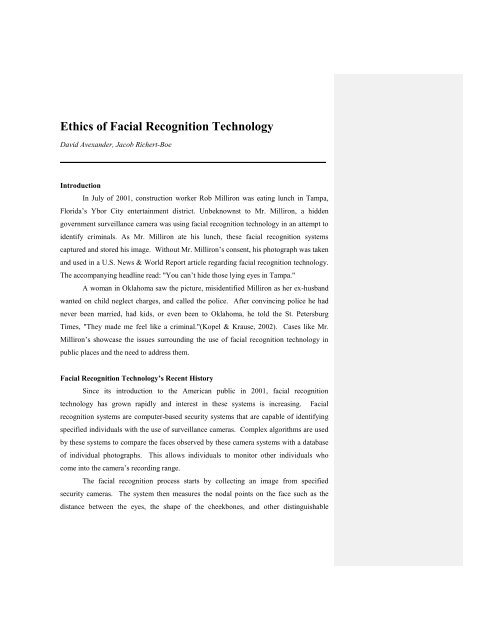
![Download Entire Book [PDF] - Ethicapublishing.com](https://img.yumpu.com/19531485/1/190x245/download-entire-book-pdf-ethicapublishingcom.jpg?quality=85)
![Download Entire Book [PDF] - Ethicapublishing.com](https://img.yumpu.com/19531484/1/190x245/download-entire-book-pdf-ethicapublishingcom.jpg?quality=85)
